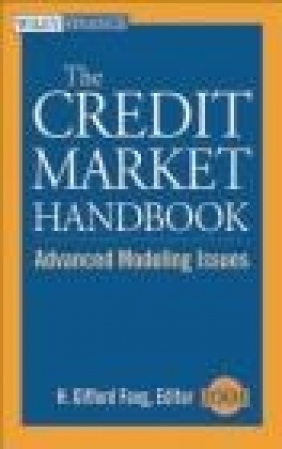Credit Market Handbook
G Fong
Credit Market Handbook
G Fong
- Producent: John Wiley
- Rok produkcji: 2006
- ISBN: 9780471778622
- Ilość stron: 256
- Oprawa: Twarda
Niedostępna
Opis: Credit Market Handbook - G Fong
In The Credit Market Handbook, financial expert and Editor H. Gifford Fong has assembled a group of prominent professionals and academics familiar with the credit arena. In each chapter, a different expert analyzes a different issue related to todaya s dynamic credit market, including portfolio credit risk, valuation models, and the importance of modeling credit default. In bringing together these noted authors and their work, Fong provides you with a rich framework of research in the area of credit analysis. Some of the topics discussed within this comprehensive guide include: aeo Estimating default probabilities implicit in equity prices aeo Structural versus reduced form models: a new information--based perspective aeo Valuing high--yield bonds aeo Predictions of default probabilities in structural models of debt aeo And much more Filled with in--depth insight and expert advice, this invaluable resource offers you the critical information you need to succeed within todaya s credit market.Introduction. Executive Chapter Summaries. CHAPTER 1: Estimating Default Probabilities Implicit in Equity Prices (Tibor Janosi, Robert Jarrow, and Yildiray Yildirim). Introduction. The Model Structure. Description of the Data. Estimation of the State Variable Process Parameters. Equity Return Estimation. Analysis of the Time Series Properties of the Parameters. Analysis of Fama--French Four--Factor Model with No Default. Analysis of a Bubble Component (P/E ratio) in Stock Prices. Analysis of the Default Intensity. Relative Performance of the Equity Return Models. Comparison of Default Intensities Based on Debt versus Equity. Conclusions. Notes. References. Appendix. CHAPTER 2: Predictions of Default Probabilities in Structural Models of Debt (Hayne E. Leland). Introduction. Recent Empirical Studies. Structural Models and Default Risk. The Default Boundary in Exogenous and Endogenous Cases. The Default Probability with Constant Default Barrier. Calibration of Models: The Base Case. Matching Empirical Default Frequencies with the L--T Model. Matching Empirical DPS with the L--S Model. The Moody's--KMV Approach. Some Preliminary Thoughts on the Relationship Between the KMV Approach and L--S/L--T. Conclusions. Acknowledgments. Postscript. Appendix. Notes. References. CHAPTER 3: Survey of the Recent Literature: Recovery Risk (Sanjiv R. Das). Introduction. Empirical Attributes. Recovery Conventions. Recovery in Structural Models. Recovery in Reduced--Form Models. Measure Transformations. Summary and Speculation. References. CHAPTER 4: Non--Parametric Analysis of Rating Transition and Default Data (Peter Fledelius, David Lando, and Jens Perch Nielsen). Introduction. Data and Outline of Methodology. Estimating Transition Intensities in Two Dimensions. One--Dimensional Hazards and Marginal Integration. Confidence Intervals. Transitions: Dependence on Previous Move and Duration. Multiplicative Intensities. Concluding Remarks. Acknowledgments. Notes. References. CHAPTER 5: Valuing High--Yield Bonds: A Business Modeling Approach (Thomas S. Y. Ho and Sang Bin Lee). Introduction. Specification of the Model. A Numerical Illustration. Empirical Evidence. Implications of the Model. Conclusions. Acknowledgments. Appendix. Notes. References. CHAPTER 6: Structural versus Reduced--Form Models: A New Information--Based Perspective (Robert A. Jarrow and Philip Protter). Introduction. The Setup. Structural Models. Reduced--Form Models. A Mathematical Overview. Observable Information Sets. Conclusion. Acknowledgment. Notes. References. CHAPTER 7: Reduced--Form versus Structural Models of Credit Risk: A Case Study of Three Models (Navneet Arora, Jeffrey R. Bohn, and Fanlin Zhu). Introduction. Merton, Vasicek--Kealhofer, and Hull--White Models. Data and Empirical Methodology. Results. Conclusion. Acknowledgments. Notes. References. CHAPTER 8: Implications of Correlated Default for Portfolio Allocation to Corporate Bonds (Mark B. Wise and Vineer Bhansali). Introduction. A Model for Default. The Portfolio Problem. Sample Portfolios with Zero Recovery Fractions. Sample Portfolios with Nonzero Recovery Fractions. Concluding Remarks. Acknowledgments. Notes. References. CHAPTER 9: Correlated Default Processes: A Criterion--Based Copula Approach (Sanjiv R. Das and Gary Geng). Introduction. Description of the Data. Copulas and Features of the Data. Determining the Joint Default Process. Simulating Correlated Defaults and Model Comparisons. Discussion. Acknowledgments. Appendix: The Skewed Double Exponential Distribution. Notes. References. Index.
Szczegóły: Credit Market Handbook - G Fong
Tytuł: Credit Market Handbook
Autor: G Fong
Producent: John Wiley
ISBN: 9780471778622
Rok produkcji: 2006
Ilość stron: 256
Oprawa: Twarda
Waga: 0.44 kg



















